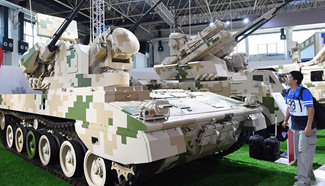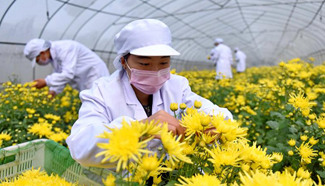by Zou Huitong, Chen Yanbei
LOS ANGELES, Nov. 2 (Xinhua) -- Almost all materials expand as temperature increases. A new lightweight metamaterial may provide a new way to construct sustained infrastructures and improve our lives, a materials scientist told Xinhua on Monday.
Common materials have the property of "positive thermal expansion," meaning when heated, they expand. In the past, railway tracks are built with separate parts. There are "thermal gaps" between neighboring components. The gap serves as a buffer zone, so that the components would not squeeze into each other and make the whole construction deformed. Although the welded tracks we see now have been stretched in advance before being installed, they are still under the risk of buckling.
A new 3D-printed lightweight material may provide a solution: engineers from USC, MIT, UCLA and Lawrence Livermore National Laboratory (LLNL) successfully made it shrink when heated. The result was recently published in the journal Physical Review Letters.
This new material is what scientists call a "metamaterial," a composite material with custom-designed structure not normally found in nature. It is made from a lattice with star-shaped structures, and incorporates two separate materials with different, but positive, thermal expansion coefficients and elastic properties. One is a stiff, slow-to-expand copper-containing material, the other a more elastic, fast-expanding polymer substance.
Although proposed theoretically in the mid-1990s, these structures have only been produced now using 3D printing technology, in particular a new technique, named "microstereolithography," by the Fang Lab at MIT. Researchers plan to explore new 3D printing technologies so that they can create structures with more than two materials.
Ultimately, the limitations of the current 3D printing technology would be the biggest challenge facing scientists to further exploration. As the printer requires the material to be in certain forms (e.g. liquefied, powdered, etc.), how to synthesize new materials that can be used in 3D printing technology is the first problem to tackle. "This is the part where we need the help from chemists." Wang said.
For application that requires materials to resist thermal expansion rather than shrink with increasing temperature, scientist have two approaches. "One is to combine this material with negative thermal expansion with those with positive thermal expansion, while the other is to improve the design of the currently shrinking structure," Qiming Wang, an assistant professor at the University of Southern California, told Xinhua.
Zero expansion materials can improve our lives. Traveling by railways will be safer, bridges and other infrastructures will be more sustained, computers will perform better with more stable microchips as those are in use today whose performance are currently hampered by rising temperatures during long-time use.
"In terms of dental filling," Dr. Wang said, "optimally put, if we manage to find biocompatible material, which means that it would not cause conflicts with human bodies, consumers can expect to witness those materials being put in practical use in the near future and the new material will be affordable to ordinary people."










